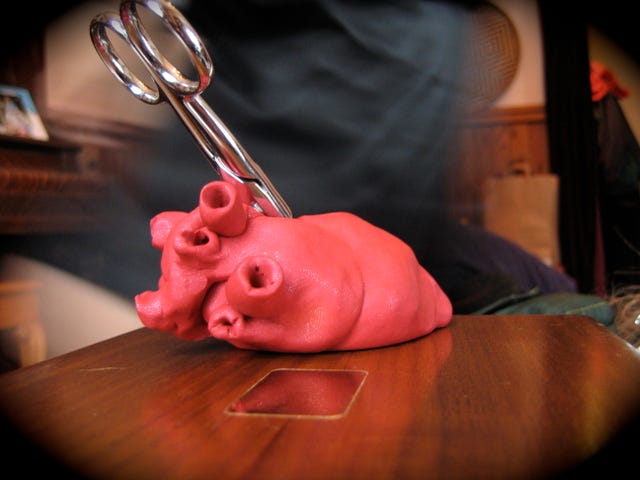Keep Your Shears in My Heart
Why Diamond (Sharp Shears) Are a Girl’s Best Friend
My sweetheart Jonny made a Fimo heart for me to stash my beloved shears.
“You're in My Heart” is carved on the left ventricle. Is that love, or what?
There is no more important tool in a sewing basket, (or the kitchen), than a fine pair of scissors. You can grab thread anywhere, or settle for a ball of twine. You can hand-sew the rest of your life without a machine. But you CANNOT cut cloth— or slash to a perfect point— with a butter knife, or your greasy thumbs.
One perfect pair of scissors is not enough, either— you need a quiver. Cost is beside the point when it comes to shears. Sell blood if you need to. If you can’t cut out a design to your satisfaction, your sewing career is screwed. Big, little, serrated, rotary, pinking—even the Swiss Army utility knife should be part of your repertoire.
I’m not kidding about the last item. The two most important family firms in Switzerland—in my estimation— are Bernina and Wenger, and one year they made a 111th Anniversary Jubilee tool, which they called a “Lady’s Knife.” You can only find them used now, but what a prize!
Next, you must cultivate a sharpener, a craftsperson who sharpens your blades. Treat them like a lover. This is the person who keeps your shears braced for a lifetime. See them often, praise them.
There are scandals in scissor-making, like everything else. Sewing and crafts people are still talking about the Great Scissors Panic of 2006. Gingher, the “premier maker of fine shears,” was acquired in 2005 by Fiskars, who makes the lightweight steel choppers you see in every office supply store. Fiskar’s familiar orange-handled shears made a decent cheap sewing scissors, as long as you replace them every year.
However, within a year of the firms’ merger, quality of both brands’ scissors plummeted. Some blamed “Mexico” for the disaster, when they saw the country’s name forged on the new poor product. Gingher hadn’t used a Mexican forge before, but to blame the country’s character is ignorant, and insulting. (Please note Mexican ironwork). Gingher is quite capable of setting standards and hiring wonderful people, no matter what country they’ve done business in.
Whatever the real story was, buyers who thought they were getting the occasional odd lemon, realized that every batch was turning bad.
Within weeks, dressmakers were in a panic to find the “vintage” Ginghers forged in Germany, Brazil, or Italy. I locked my drawers, and tied my cherished Knife Edge Tailor's Point Scissors around my neck.
Luckily Fiskars new management responded to the outcry, and things got back “almost” to normal. Their Ginghers imprint is still the best new blades you can buy.
“What’s an effective scissors test?” you may ask.
Try this: Take four layers of cloth, and make a cut. It should be clean, and slash straight through to the very tips of the blades. Think: surgical.
They should fit comfortably and light enough in your hand that you could cut out Cinderella’s ballgown without getting a cramp.
They should cut leather easily.
A lock-nut assembly for easy readjustment of tension would be essential.
And yeah, they should look nice.
What about the longer shears you need for cutting yardage? You know what, it’s the SAME style of blades you should be using in the kitchen!
(The crap that gets sold as “kitchen scissors” are garbage and you already know how quickly they wear out).
For any kind of cutting, whether it’s edible or sewable, these are the best: The Ginger 8” Dressmaker Shears.
I don’t care if you’re a “lady,” or a foul-mouthed bricoleur, you need pair of blades that make you sing while you slash. The pains of global capitalism may be nipping at the heels of good craftsmanship, but somewhere out there, there’s a pair with your name on them.


